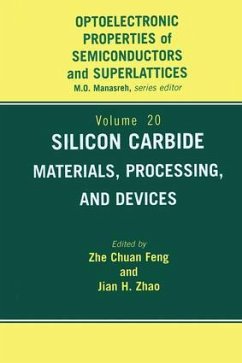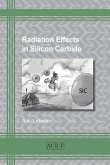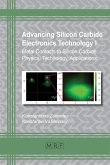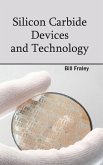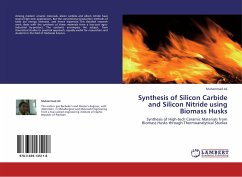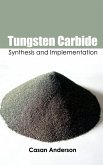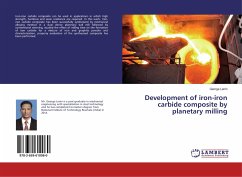- Gebundenes Buch
- Merkliste
- Auf die Merkliste
- Bewerten Bewerten
- Teilen
- Produkt teilen
- Produkterinnerung
- Produkterinnerung
This book explores the history and latest developments in the SiC field, with an emphasis on the properties and applications of SiC to electronics and optoelectronics.
Andere Kunden interessierten sich auch für
![Radiation Effects in Silicon Carbide Radiation Effects in Silicon Carbide]() A. A. LebedevRadiation Effects in Silicon Carbide99,99 €
A. A. LebedevRadiation Effects in Silicon Carbide99,99 €![Silicon Carbide 2008 - Materials, Processing and Devices Silicon Carbide 2008 - Materials, Processing and Devices]() Silicon Carbide 2008 - Materials, Processing and Devices99,99 €
Silicon Carbide 2008 - Materials, Processing and Devices99,99 €![Advancing Silicon Carbide Electronics Technology I Advancing Silicon Carbide Electronics Technology I]() Advancing Silicon Carbide Electronics Technology I130,99 €
Advancing Silicon Carbide Electronics Technology I130,99 €![Silicon Carbide Devices and Technology Silicon Carbide Devices and Technology]() Silicon Carbide Devices and Technology164,99 €
Silicon Carbide Devices and Technology164,99 €![Synthesis of Silicon Carbide and Silicon Nitride using Biomass Husks Synthesis of Silicon Carbide and Silicon Nitride using Biomass Husks]() Muhammad AliSynthesis of Silicon Carbide and Silicon Nitride using Biomass Husks32,99 €
Muhammad AliSynthesis of Silicon Carbide and Silicon Nitride using Biomass Husks32,99 €![Tungsten Carbide Tungsten Carbide]() Tungsten Carbide87,99 €
Tungsten Carbide87,99 €![Development of iron-iron carbide composite by planetary milling Development of iron-iron carbide composite by planetary milling]() George LeninDevelopment of iron-iron carbide composite by planetary milling24,99 €
George LeninDevelopment of iron-iron carbide composite by planetary milling24,99 €-
-
-
This book explores the history and latest developments in the SiC field, with an emphasis on the properties and applications of SiC to electronics and optoelectronics.
Hinweis: Dieser Artikel kann nur an eine deutsche Lieferadresse ausgeliefert werden.
Hinweis: Dieser Artikel kann nur an eine deutsche Lieferadresse ausgeliefert werden.
Produktdetails
- Produktdetails
- Verlag: CRC Press
- Seitenzahl: 400
- Erscheinungstermin: 30. Oktober 2003
- Englisch
- Abmessung: 235mm x 157mm x 26mm
- Gewicht: 728g
- ISBN-13: 9781591690238
- ISBN-10: 1591690234
- Artikelnr.: 54589972
- Herstellerkennzeichnung
- Libri GmbH
- Europaallee 1
- 36244 Bad Hersfeld
- gpsr@libri.de
- Verlag: CRC Press
- Seitenzahl: 400
- Erscheinungstermin: 30. Oktober 2003
- Englisch
- Abmessung: 235mm x 157mm x 26mm
- Gewicht: 728g
- ISBN-13: 9781591690238
- ISBN-10: 1591690234
- Artikelnr.: 54589972
- Herstellerkennzeichnung
- Libri GmbH
- Europaallee 1
- 36244 Bad Hersfeld
- gpsr@libri.de
Dr. Zhe Chuan Feng received his Ph.D. from the University of Pittsburgh. He has worked both within academia and industry on semiconductor growth, process, characterization, semiconductor devices, and lasers. He is currently a Senior Research Scientist at the School of Electrical & Computer Engineering at the Georgia Institute of Technology, focusing on widegap III-Nitrides, SiC and other compound semiconductors. Dr. Jian H. Zhao received his Ph.D. in Electrical Engineering from Carnegie Mellon University in 1988 and joined Rutgers University in the same year. He is Professor and Director of SiCLAB and his research results have been summarized in more than 110 refereed papers and over 140 conference papers and presentations, as well as four book chapters and a book titled Optical Filter Design and Analysis: A Signal Processing Approach. He holds five patents.
Preface Chapter 1 Epitaxial growth of high-quality silicon carbide - Fundamentals and recent progress - -- T. Kimoto and H. Matsunami* (Kyoto University) (1) Introduction (2) Step-controlled Epitaxy of SiC 2.1 Chemical vapor deposition 2.2 Step-controlled epitaxy 2.3 Surface morphology (3) Growth mechanism of step-controlled epitaxy 3.1 Rate-determining process 3.2 Off-angle dependence of growth rate 3.3 Temperature dependence of growth rate 3.4 Prediction of step-flow growth condition 3.4.1 Surface diffusion model 3.4.2 Desorption flux 3.4.3 Critical supersaturation ratio 3.4.4 Critical growth conditions 3.4.5 Surface diffusion length 3.4.6 Prediction of growth mode (4) Behaviors of steps in SiC epitaxy 4.1 Nucleation and step motion 4.2 Step bunching (5) Characterization of epitaxial layers 5.1 Structural characterization 5.2 Optical characterization 5.3 Electrical characterization (6) Doping of impurities 6.1 Donor doping 6.2 Acceptor doping (7) Recent progress 7.1 Practical epitaxial growth 7.2 Epitaxial growth on (11-20) (8) Concludions References Chapter 2 Surface characterization of 6H-SiC reconstructions -- Kian-Ping LOH, Eng-Soon TOK, and Andrew T. S. WEE* (National University of Singapore) 1. INTRODUCTION 2. Sample preparation methods for characterization of surface reconstruction 3. Reflection High Energy Electron Diffraction (RHEED) 3.1 RHEED system set-up 3.2 RHEED analysis of surface reconstruction on 6H-SiC (0001) 3.3 6H-SiC (0001)-(1
1) reconstruction 3.4 6H-SiC (0001)-(3
3) reconstruction 3.5 6H-SiC(0001)-(6×6) reconstruction 3.6 6H-SiC(0001)-(Ö3
Ö3R ) reconstruction 3.7 1
1 graphite-R on 1
1 SiC 3.8 RHEED Rocking beam analysis 4. Scanning Tunneling Microscopy (STM) 4.1 Surface Morphological Evolution of 6H-SiC(0001) 4.2 6H-SiC (0001)-(3&
1) reconstruction 3.4 6H-SiC (0001)-(3
3) reconstruction 3.5 6H-SiC(0001)-(6×6) reconstruction 3.6 6H-SiC(0001)-(Ö3
Ö3R ) reconstruction 3.7 1
1 graphite-R on 1
1 SiC 3.8 RHEED Rocking beam analysis 4. Scanning Tunneling Microscopy (STM) 4.1 Surface Morphological Evolution of 6H-SiC(0001) 4.2 6H-SiC (0001)-(3&
Preface Chapter 1 Epitaxial growth of high-quality silicon carbide - Fundamentals and recent progress - -- T. Kimoto and H. Matsunami* (Kyoto University) (1) Introduction (2) Step-controlled Epitaxy of SiC 2.1 Chemical vapor deposition 2.2 Step-controlled epitaxy 2.3 Surface morphology (3) Growth mechanism of step-controlled epitaxy 3.1 Rate-determining process 3.2 Off-angle dependence of growth rate 3.3 Temperature dependence of growth rate 3.4 Prediction of step-flow growth condition 3.4.1 Surface diffusion model 3.4.2 Desorption flux 3.4.3 Critical supersaturation ratio 3.4.4 Critical growth conditions 3.4.5 Surface diffusion length 3.4.6 Prediction of growth mode (4) Behaviors of steps in SiC epitaxy 4.1 Nucleation and step motion 4.2 Step bunching (5) Characterization of epitaxial layers 5.1 Structural characterization 5.2 Optical characterization 5.3 Electrical characterization (6) Doping of impurities 6.1 Donor doping 6.2 Acceptor doping (7) Recent progress 7.1 Practical epitaxial growth 7.2 Epitaxial growth on (11-20) (8) Concludions References Chapter 2 Surface characterization of 6H-SiC reconstructions -- Kian-Ping LOH, Eng-Soon TOK, and Andrew T. S. WEE* (National University of Singapore) 1. INTRODUCTION 2. Sample preparation methods for characterization of surface reconstruction 3. Reflection High Energy Electron Diffraction (RHEED) 3.1 RHEED system set-up 3.2 RHEED analysis of surface reconstruction on 6H-SiC (0001) 3.3 6H-SiC (0001)-(1
1) reconstruction 3.4 6H-SiC (0001)-(3
3) reconstruction 3.5 6H-SiC(0001)-(6×6) reconstruction 3.6 6H-SiC(0001)-(Ö3
Ö3R ) reconstruction 3.7 1
1 graphite-R on 1
1 SiC 3.8 RHEED Rocking beam analysis 4. Scanning Tunneling Microscopy (STM) 4.1 Surface Morphological Evolution of 6H-SiC(0001) 4.2 6H-SiC (0001)-(3&
1) reconstruction 3.4 6H-SiC (0001)-(3
3) reconstruction 3.5 6H-SiC(0001)-(6×6) reconstruction 3.6 6H-SiC(0001)-(Ö3
Ö3R ) reconstruction 3.7 1
1 graphite-R on 1
1 SiC 3.8 RHEED Rocking beam analysis 4. Scanning Tunneling Microscopy (STM) 4.1 Surface Morphological Evolution of 6H-SiC(0001) 4.2 6H-SiC (0001)-(3&

